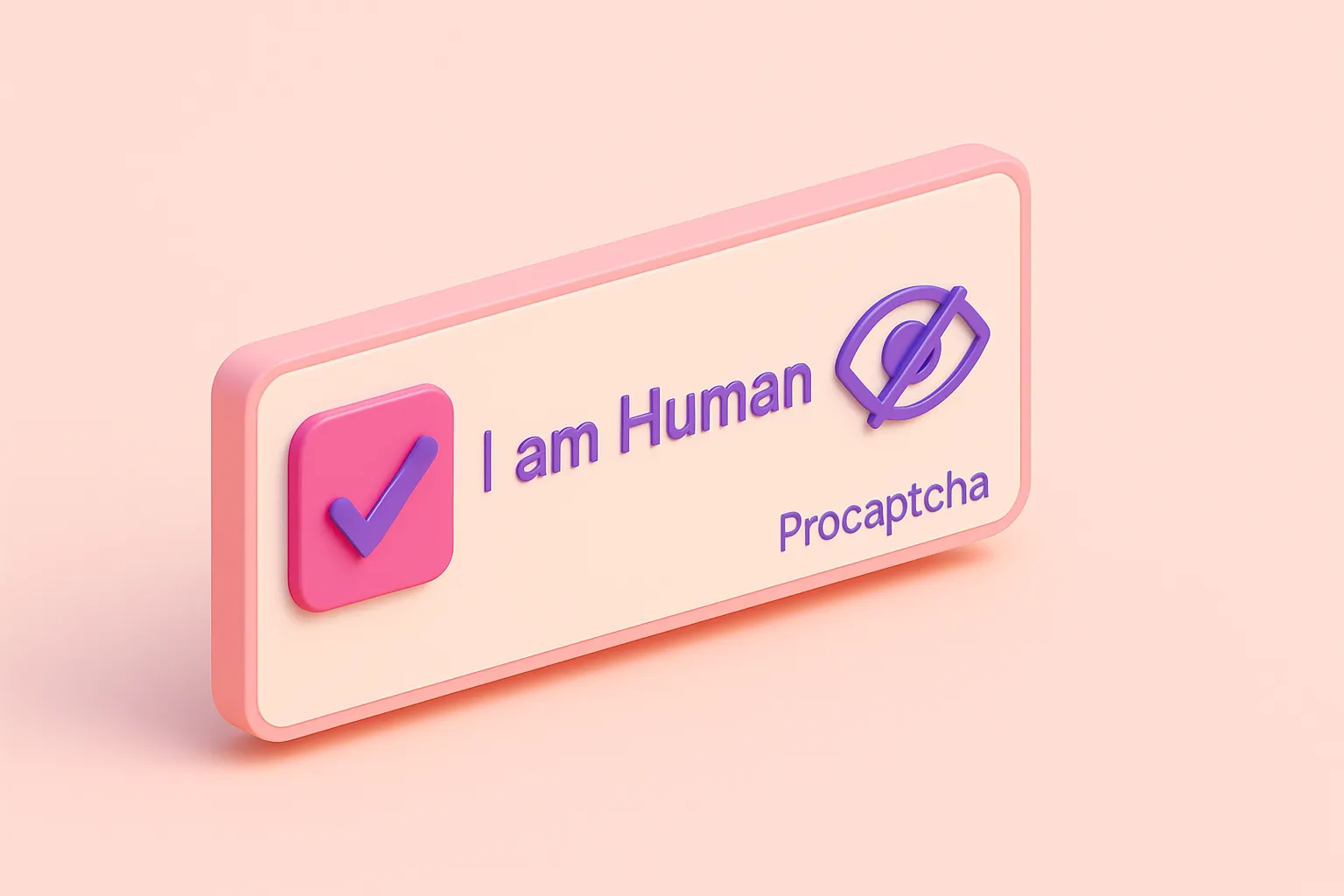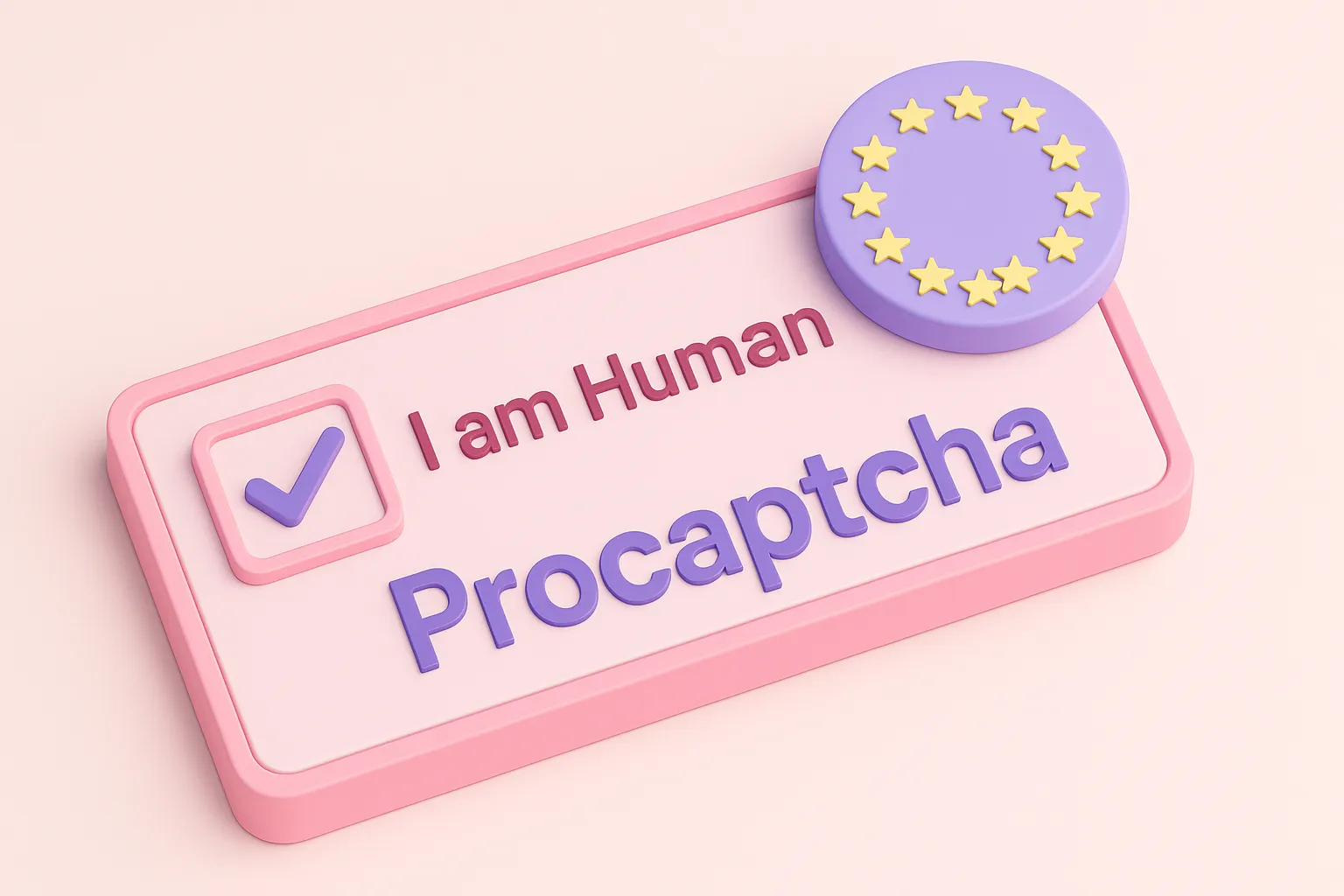How to Make CAPTCHA GDPR Compliant & Protect Privacy
Did you know that bots make up nearly half of all internet traffic, with malicious bots accounting for 32%? While CAPTCHAs help block automated attacks, some silently collect user data, creating privacy risks.
Understanding how to make CAPTCHA GDPR compliant is not just about avoiding fines - it's about ethical web practices and user trust. Surprisingly, many organizations violate privacy laws unknowingly with each form submission. Let's fix that today.
In this article, we will:
- Master these seven steps for GDPR-compliant CAPTCHAs
- Apply these privacy-focused code solutions
- Find answers to your compliance questions
7 Essential Steps to Create GDPR-Compliant CAPTCHAs That Protect Both Users and Your Business
Before diving into implementation, it's crucial to understand what the GDPR demands from your CAPTCHA systems:
Data Processing Principles: Any CAPTCHA must adhere to the core GDPR principles of lawfulness, fairness, transparency, purpose limitation, data minimization, accuracy, storage limitation, integrity, and accountability.
CAPTCHA systems often collect various types of data, including:
- IP addresses
- Browser information
- Mouse movements
- Interaction patterns
- Cookie data
- Sometimes biometric data (in behavioral analysis)
Step-by-Step Process to Ensure GDPR-Compliant CAPTCHA Implementation
Image: https://pixabay.com/illustrations/[gdpr](/glossary/terms/gdpr/)-regulation-protection-data-3438443/
 Follow these proven steps to transform your CAPTCHA from a compliance risk into a privacy asset.
Follow these proven steps to transform your CAPTCHA from a compliance risk into a privacy asset.
Step 1: Establish a Valid Legal Basis
You must have a legitimate reason to process personal data through your CAPTCHA. The two most applicable legal bases are:
- Legitimate interest: Protecting your website from spam and bot attacks
- Consent: Explicit user agreement to data processing
Most organizations rely on legitimate interest for CAPTCHA implementation, but this requires documenting your legitimate interest assessment to demonstrate that your security interests outweigh potential privacy impacts.
Step 2: Update Your Privacy Policy
Your privacy policy must explicitly mention:
- That you use CAPTCHA technology
- What data is collected
- How long data is retained
- The legal basis for processing
- Which third parties (if any) have access to the data
Be transparent about what happens behind the scenes when users interact with your CAPTCHA.
Step 3: Choose a GDPR-Friendly CAPTCHA Solution
Not all CAPTCHA technologies are created equal when it comes to privacy. Consider:
- Invisible CAPTCHA options that require minimal user interaction
- Solutions with EU-based data processing
- Providers that offer customizable data collection settings
- CAPTCHA systems with strong data protection agreements
hCaptcha and newer versions of reCAPTCHA have made significant improvements in GDPR compliance but require careful configuration.
Step 4: Implement Data Minimization
Collect only what you absolutely need to determine human from bot:
- Configure your CAPTCHA to collect minimal personal data
- Set the shortest possible data retention periods
- Anonymize or pseudonymize data where possible
- Disable unnecessary tracking features
This may require working with your CAPTCHA provider to customize settings beyond defaults.
Step 5: Ensure Accessibility Alongside Compliance
GDPR compliance should not come at the expense of accessibility. Implement:
- Multiple verification methods (audio alternatives, simple puzzles)
- Clear instructions for all users
- Reasonable accommodations for users with disabilities
This dual focus ensures your CAPTCHA solution doesn't discriminate while remaining compliant.
Step 6: Document Your Compliance Measures
Documentation is crucial for demonstrating compliance. Maintain records of:
- Your CAPTCHA implementation decisions
- Data processing impact assessment
- Security measures implemented
- Regular compliance reviews
- User complaints and resolutions related to CAPTCHA
This documentation serves as your protection in case of regulatory questions.
Step 7: Regularly Test and Update Your Implementation
GDPR compliance isn't a one-time achievement. Schedule regular reviews of your CAPTCHA implementation to:
- Test for unnecessary data collection
- Verify that retention periods are being respected
- Ensure privacy notices remain accurate
- Adapt to evolving regulatory guidance
Essential GDPR Compliance Checklist for CAPTCHA Implementation
Use this checklist to verify your CAPTCHA implementation meets GDPR requirements:
- [ ] Legal basis clearly established and documented
- [ ] Privacy policy updated with CAPTCHA-specific information
- [ ] Data processing agreement in place with CAPTCHA provider
- [ ] Data minimization principles applied to collection settings
- [ ] Appropriate retention periods established and enforced
- [ ] Accessible alternatives are provided for all users
- [ ] Data subject rights procedures cover CAPTCHA data
- [ ] Regular compliance audits scheduled
- [ ] Staff trained in handling CAPTCHA-related privacy inquiries
- [ ] Documentation maintained for accountability purposes
Remember that compliance is an ongoing process, not a destination. As CAPTCHA technologies evolve and regulatory interpretations develop, stay informed and be prepared to adapt your implementation accordingly.
Code-Level Strategies: Privacy-Focused CAPTCHA Implementation Blueprints
When it comes to implementing a GDPR friendly CAPTCHA, technical execution is key to ensuring compliance and security. * Good intentions aren't enough* – you need proper execution at the code level.
Below, we have provided practical, hands-on examples to help developers implement privacy-respecting CAPTCHA solutions.
Configuring reCAPTCHA to Maximize Privacy Protection
Google's reCAPTCHA is ubiquitous, but its default settings aren't always GDPR-optimal. Here's how to configure it with privacy in mind:
Use reCAPTCHA v3 with Minimized Data Collection
reCAPTCHA v3 operates invisibly and scores user interactions based on behavior. The key to GDPR compliance lies in proper implementation:
<!-- Add to your HTML head section -->
<script src="https://www.google.com/recaptcha/api.js?render=YOUR_SITE_KEY"></script>
<script>
// Only execute reCAPTCHA when absolutely necessary (e.g., form submission)
document.getElementById('contact-form').addEventListener('submit', function(event) {
event.preventDefault();
// Execute reCAPTCHA with limited scope
grecaptcha.execute('YOUR_SITE_KEY', {action: 'submit_form'})
.then(function(token) {
// Include token in form submission
document.getElementById('g-recaptcha-response').value = token;
document.getElementById('contact-form').submit();
});
});
</script>Privacy improvements in this implementation:
- CAPTCHA only runs when needed (form submission)
- Limited action scope ('submit_form')
- No unnecessary page tracking
Self-Hosted CAPTCHA Backend Verification
For maximum data control, implement server-side validation that minimizes data sharing:
<?php
// Server-side verification with minimal data sharing
function verifyCaptcha($recaptcha_response) {
// Only necessary parameters sent to Google
$verification_data = [
'secret' => 'YOUR_SECRET_KEY',
'response' => $recaptcha_response,
// Deliberately NOT sending user IP - increases privacy
// 'remoteip' => $_SERVER['REMOTE_ADDR']
];
$options = [
'http' => [
'header' => "Content-type: application/x-www-form-urlencoded\r\n",
'method' => 'POST',
'content' => http_build_query($verification_data)
]
];
$context = stream_context_create($options);
$result = file_get_contents('https://www.google.com/recaptcha/api/siteverify', false, $context);
$result_data = json_decode($result);
// Log minimal verification data - exclude user identifiers
error_log('CAPTCHA verification attempted. Success: ' . ($result_data->success ? 'Yes' : 'No'));
return $result_data->success && $result_data->score >= 0.5;
}
?>This approach deliberately omits sending the user's IP address to Google, reducing the personal data footprint while maintaining security.
Implementing Proper Consent Mechanisms
Under GDPR, when using legitimate interest as your legal basis, you still need to be transparent. When using consent as your basis, that consent must be explicit and informed.
Transparent Notification Banner
<div id="captcha-notice" class="privacy-notice">
<p>
This form is protected by CAPTCHA technology to prevent spam.
<strong>When you submit this form</strong>, we'll process limited interaction
data to verify you're human.
</p>
<p>
See our <a href="/privacy#captcha">Privacy Policy</a> for details on what
data is processed and how long it's retained.
</p>
<button onclick="acknowledgeCaptchaNotice()">I understand</button>
</div>
<script>
function acknowledgeCaptchaNotice() {
// Store acknowledgment in localStorage instead of cookies when possible
localStorage.setItem('captchaNoticeAcknowledged', 'true');
document.getElementById('captcha-notice').style.display = 'none';
}
// Check if user has already acknowledged
window.addEventListener('DOMContentLoaded', function () {
if (localStorage.getItem('captchaNoticeAcknowledged') === 'true') {
document.getElementById('captcha-notice').style.display = 'none';
}
});
</script>This approach clearly informs users before they engage with your CAPTCHA-protected form, supporting transparency requirements.
Explicit Consent Implementation for High-Risk Processing
For situations where you're collecting more sensitive data through behavior analysis:
// More explicit consent approach for higher-risk CAPTCHA implementations
const captchaConsentManager = {
consentGiven: false,
initialize: function() {
// Check for existing consent
this.consentGiven = localStorage.getItem('captchaConsent') === 'granted';
this.updateUI();
// Attach event listeners
document.getElementById('consent-yes').addEventListener('click', () => this.updateConsent(true));
document.getElementById('consent-no').addEventListener('click', () => this.updateConsent(false));
},
updateConsent: function(consented) {
this.consentGiven = consented;
// Record timestamp of consent for audit purposes
const consentRecord = {
status: consented ? 'granted' : 'denied',
timestamp: new Date().toISOString(),
version: '1.2' // Consent policy version
};
// Store in localStorage with expiry (90 days)
localStorage.setItem('captchaConsent', consented ? 'granted' : 'denied');
localStorage.setItem('captchaConsentDetails', JSON.stringify(consentRecord));
this.updateUI();
// Optional: Send to server for audit trail if needed
this.logConsentChange(consentRecord);
},
updateUI: function() {
document.getElementById('captcha-consent-banner').style.display =
this.consentGiven ? 'none' : 'block';
document.getElementById('submit-button').disabled = !this.consentGiven;
},
logConsentChange: function(record) {
// Send minimized data to server (audit trail)
fetch('/api/consent-log', {
method: 'POST',
headers: { 'Content-Type': 'application/json' },
body: JSON.stringify({
feature: 'captcha',
consentStatus: record.status,
consentVersion: record.version
// Deliberately NOT sending user identifiers
})
});
}
};
// Initialize consent manager
document.addEventListener('DOMContentLoaded', function() {
captchaConsentManager.initialize();
});This implementation creates a robust, documented consent mechanism that records when and what version of consent was provided – essential for accountability under GDPR.
Server-Side Validation with Minimized Data Collection
Proper server-side validation is crucial for CAPTCHA security while minimizing data collection:
# Python example using Flask
from flask import Flask, request, jsonify
import requests
import hashlib
from datetime import datetime, timedelta
app = Flask(__name__)
# In-memory temporary store instead of database
# For production, use a database with automatic deletion
temporary_verification_store = {}
@app.route('/verify-captcha', methods=['POST'])
def verify_captcha():
captcha_response = request.form.get('g-recaptcha-response')
form_id = request.form.get('form_id')
# Generate anonymous identifier instead of storing user IP
# This uses a hash of IP + form ID but ONLY stores the hash
session_now = datetime.now().strftime("%Y-%m-%d-%H")
anonymous_id = hashlib.sha256(
f"{request.remote_addr}:{form_id}:{session_now}".encode()
).hexdigest()
# Check for too many attempts from same source
attempts = temporary_verification_store.get(anonymous_id, 0)
if attempts > 5:
return jsonify({'success': False, 'error': 'rate_limit'})
# Verify with minimal data sent to CAPTCHA provider
verification_data = {
'secret': 'YOUR_SECRET_KEY',
'response': captcha_response
# IP not shared with provider
}
result = requests.post(
'https://www.google.com/recaptcha/api/siteverify',
data=verification_data
).json()
# Update counter (with auto-expiry logic)
temporary_verification_store[anonymous_id] = attempts + 1
# Schedule cleanup of old records (every 100 requests)
if len(temporary_verification_store) % 100 == 0:
cleanup_old_records()
return jsonify({
'success': result.get('success', False),
# Share minimal data with client
'error': result.get('error-codes', [])[0] if not result.get('success', False) else None
})
def cleanup_old_records():
"""Remove entries older than 1 hour to minimize data retention"""
current_hour = datetime.now().strftime("%Y-%m-%d-%H")
keys_to_remove = []
for key in temporary_verification_store:
if current_hour not in key:
keys_to_remove.append(key)
for key in keys_to_remove:
del temporary_verification_store[key]This implementation demonstrates several privacy-enhancing techniques:
- Anonymous request identification
- Rate limiting without persistent user tracking
- Minimal data sharing with the CAPTCHA provider
- Automatic data cleanup
Using localStorage Instead of Cookies Where Possible
Cookies trigger ePrivacy and GDPR consent requirements. Using localStorage can reduce compliance burden in many scenarios:
// CAPTCHA state management using localStorage instead of cookies
const privacyFriendlyCaptcha = {
initialize: function() {
// Check for verification attempts in localStorage
let attempts = localStorage.getItem('captchaAttempts');
attempts = attempts ? JSON.parse(attempts) : { count: 0, timestamp: Date.now() };
// Reset counter if older than 1 hour
if (Date.now() - attempts.timestamp > 3600000) {
attempts = { count: 0, timestamp: Date.now() };
}
localStorage.setItem('captchaAttempts', JSON.stringify(attempts));
// Implement progressive difficulty based on attempts
if (attempts.count > 3) {
this.loadStrongerCaptcha();
} else {
this.loadSimpleCaptcha();
}
}This approach employs progressive security enhancement – only increasing CAPTCHA difficulty when necessary – while using localStorage to avoid cookie consent requirements.
Implementing a Custom, Minimal CAPTCHA Solution
For ultimate control over data processing, consider a simple homegrown solution:
// Frontend implementation of minimal CAPTCHA
const simpleCaptcha = {
challenge: '',
initialize: function() {
// Generate random challenge server-side
fetch('/api/get-captcha-challenge')
.then(response => response.json())
.then(data => {
this.challenge = data.challenge;
this.displayChallenge(data.display);
});
},
displayChallenge: function(displayData) {
const container = document.getElementById('captcha-container');
container.innerHTML = `
<div class="captcha-challenge">
<p>${displayData.question}</p>
<input type="text" id="captcha-answer" aria-label="CAPTCHA answer" />
<input type="hidden" id="captcha-id" value="${displayData.id}" />
</div>
`;
},
verify: function() {
const answer = document.getElementById('captcha-answer').value;
const id = document.getElementById('captcha-id').value;
return fetch('/api/verify-captcha', {
method: 'POST',
headers: { 'Content-Type': 'application/json' },
body: JSON.stringify({ id, answer })
})
.then(response => response.json())
.then(result => {
if (result.success) {
// Clear data after successful verification
document.getElementById('captcha-answer').value = '';
} else {
// Refresh on failure
this.initialize();
}
return result.success;
});
}
};This custom solution demonstrates privacy by design by:
- Creating verification without third-party services
- Storing minimal challenge data
- Implementing automatic data deletion
- Using simple challenges that don't require behavior analysis
By following these technical implementation examples, you can create CAPTCHA systems that effectively balance security needs with GDPR privacy requirements – protecting both your users and your organization.
Secure Your Forms While Respecting User Privacy Rights
A privacy-first CAPTCHA is no longer optional - it's essential for protecting user data, avoiding fines, and maintaining trust. By minimizing data collection, ensuring transparency, and choosing secure solutions, you can effectively balance compliance and security. Regular audits and accessibility considerations further strengthen your approach.
Enhance security and privacy with Prosopo's PoW CAPTCHA - efficient, user-friendly, and built for modern web protection. Get started today!
Related Posts to How to Make CAPTCHA GDPR Compliant & Protect Privacy

Which Security Risks Does CAPTCHA Pose: Critical Flaws?
Tue, 25 Mar 2025

What do Artists do to Prevent Ticket Scalping?
Wed, 02 Apr 2025

What is the Future of CAPTCHA and Online Privacy
Thu, 03 Apr 2025

What Privacy Laws Should CAPTCHA Providers Comply With
Sun, 06 Apr 2025

How Do Scalpers Get Tickets Before Selling Them
Wed, 09 Apr 2025

How to Integrate CAPTCHA Without Violating User Rights
Sat, 12 Apr 2025

How to Choose a GDPR-Friendly CAPTCHA for WordPress
Fri, 18 Apr 2025

How Does CAPTCHA Collect User Data? The Reality
Fri, 25 Apr 2025

🎫 Preventing Ticket Bots - The Battle for Fair Access
Sun, 02 Nov 2025

Survey Companies Are Having Their Data Compromised by AI Bots
Tue, 25 Nov 2025
Start for free today. No credit card required.
